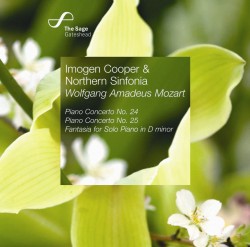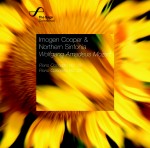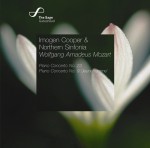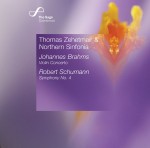
Mozart: Piano Concertos Nos. 24 & 25 • Fantasia in D Minor
Imogen Cooper, piano, director
Bradley Creswick, co-director
Royal Northern Sinfonia
31st August 2008
AV2175
£12.99 (1CD Jewel Case | 24-page booklet)
Summary:
“Imogen Cooper and the Northern Sinfonia do ample justice to the gravitas, intensity, drama, and poignancy of this great work” ★★★★ – BBC Music magazine
“Imogen Cooper… understands her role in terms of expressive interplay and dynamic nuance. These interpretations are profoundly felt, excellently played” – Gramophone
“Cooper’s beauty of line and subtlety of colouring … the finale is well-nigh ideal in its mingled grace and energy, its central oboe-piano love duet phrased with exquisite tenderness” – The Daily Telegraph
Beethoven was deeply impressed, if not taken aback, by Mozart’s C minor Piano Concerto K491 at a concert in 1800. And when the finale was played he exclaimed, despairingly to his publisher seated next to him: ‘We shall never be able to do anything like that!’
Beethoven of course, did quite a lot like it, eventually – the finale of his Appassionata sonata acknowledges the influence of K491 – but the point was made: Mozart’s skill in the combining of virtuoso piano playing and symphonic melody in a soloist-orchestra partnership was supreme and transformed the concerto form from that time onwards.
The C minor work was written for one of Mozart’s own performances and received its premiere in the spring of 1786. Judging from the original manuscript it was written in a hurry and some of the passages had not come easily, as they had been reworked several times. K491 calls for the largest orchestra Mozart ever used for a piano concerto. The greater use of oboes, clarinets and trumpets also testifies to his great love of wind instruments which his works were now helping to raise in orchestral status.The subdued Allegro opening in 3/4 time for strings, underpinned by the winds, tiptoes in and soon gives way to the full orchestra’s version of the theme with its upward, skipping notes. The piano enters this sombre, uncertain world cautiously but then, as the theme is developed, enjoys a rich and harmonious partnership with the orchestra.
The piano opens the delightful Larghetto with a simple lullaby-like tune which is then elegantly expanded upon in rondo form by the winds and strings.
The Allegretto finale is a series of variations on a vigorous march theme which, spurred on by the piano, presents those lately-liberated wind instruments in particular with a joyful field day.
© Richard Yates of the Newcastle Evening Chronicle
Tracklist:
WOLFGANG AMADEUS MOZART (1756–1791)
Concerto for Piano and Orchestra in C minor, No. 24, K491 (30:42)
1. I Allegro (cadenza: Alfred Brendel) (13:40)
2. II Larghetto (7:40)
3. III (Allegretto) (9:16)
Concerto for Piano and Orchestra No. 25 in C major, K503 (32:25)
4. I Allegro Maestoso (cadenza: Alfred Brendel) (15:35)
5. II Andante (7:54)
6. III Allegretto (8:53)
7. Fantasia in D minor, K397 (6:22)
Total Duration: 69:56
Recorded 8 – 11 November 2007 in Hall One of The Sage Gateshead, England
Recording produced, engineered and edited by Simon Fox-Gál







